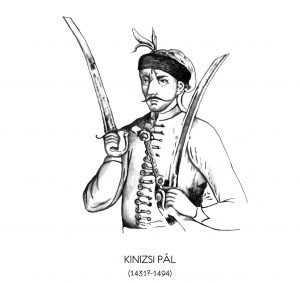 General, Lord Lieutenant, Captain General and Lord Chief of Justice of the South region
General, Lord Lieutenant, Captain General and Lord Chief of Justice of the South region
King Matthias entrusted the battle against the Turks to his renowned general, Pál Kinizsi. Tradition has it that Kinizsi was born in Kinis, Bihar county (today Bihor county, Romania). According to Romanian sources his birthplace might have been in Kenézfalva (today Satchinez, Romania). Romanian historians prefer using his Romanian name: Paul Chinezu. The Kinizsi family is of Serb origin. Kinizsi’s father fought against the Turks in Janos Hunyadi’s army.
His name was first mentioned in King Matthias’s Ordinance as Lord Lieutenant of Máramaros County (today Maramureş County, Romania). He became famous as Bálazs Magyar’s second in command in 1468 in the battle against Moravia. In 1427, for his faithful services, he was given the castle of Vázsony and its estates. He added to the “Kinizsi castle” a palace and a Barbican. He is also a hero of a lot of tales. According to one of the most famous tales, Balázs Vastag’s daughter asked Kinizsi for a drink. Kinizsi was lying on the ground next to his father’s mill. He brought her a cup of water and served it on a millstone.
In 1478 Kinizsi brought monks to Vázsony, a place which by then had become a market-town. He ordered a monastery and a church to be built for them. In the same year King Mathias appointed Pál Kinizsi Lord Lieutenant of Temes county (today Timiş county, Romania) and Captain-general of Southern Hungary. It was here that he received Bálazs Vastag’s message in which he was asking him to help defeat the Turkish troops. On October 13, 1479, István Bathori, Voivod of Transylvania with his 12-15000 men was losing the Battle of Kenyérmező against a Turkish troop of 20000 soldiers. Kinizsi’s heroic intervention saved the Hungarian troops from losing the battle.
In 1480 Kinizsi married Benigna, Balázs Magyar’s daughter. In 1480 he was given the castle of Somló. In 1481 King Matthias entrusted him with the defence of the southern borders, because pasha Iskander was plundering and destroing the surroundings of Temesvár (today Timişoara, Romania). Kinizsi managed not only to beat the Turks off, but also to completely destroy the Turkish troops at Galambóc, in Serbia. There were thousands of Turks lying dead on the battlefield, pasha Iskander also lost his life in the battle. A lot of Serbs asked Kinizsi to let them settle down in Hungary. Kinizsi let 25-30000 Serbs settle down in the Southern counties, in Nagypalánk, in one of Temesvár’s quarters.
In 1483 Sultan Bayasid II signed a five-year armistice with King Matthias, which was prolonged with another 3 years. This gave the opportunity to Kinizsi to restore the situation in the devastated Temesvár and its surroundings. But this peaceful period did not last long, the armistice was still in force when the Turks started their predatory expeditions in Temes county. They arrived up to the outskirts of Temesvár, where Kinizsi managed to core them away.
After the death of King Matthias the peace of the region was threatened not only by the Turkish troops, but also by the despotic oligarch of the region. Kinizsi decided to side King Vladislas II against János Korvin, who was claiming the throne. Kinizsi restored peace along the river Drava and Sava and together with his fellow commander managed to reconquer the town of Székesfehérvár, previously occupied by Kaiser Miksa. In 1492 Kinizsi destroyed the Black Army, ones King Matthias’ renowned army, which was already falling apart. In 1494 Kinizsi had a stroke. In spite of Kinizsi’s illness, Vladislas II appointed him Lord Chief Justice of Hungary. On September 25, 1494 he came to Temesvár and spent 5 days in the castle as Kinizsi’s guest. At that time, Temesvár was mentioned in a document as Lord Lieutenant of Temes County, Pál Kinizsi’s home town. “Civitas Themesensis et castrum in eadem habitum, habitatio scilicet M. domini Pauli de Kenys, comitis Themesensis”
On November 13, 1494 the king sent Kinizsi to conquer the castle of Szendrő, but he was not able to fulfil this task, since he got a deathly fever and on September 24, 1494 died in Szentendre, a market town which is situated on the left of the River Sava.
